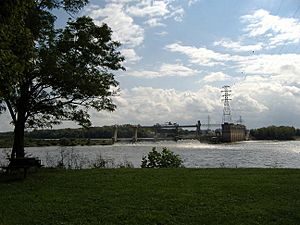Shippingport, Kentucky facts for kids
Shippingport, Kentucky was once an important town located on a small piece of land next to the Ohio River in what is now Louisville, Kentucky. It was one of several early settlements near the Falls of the Ohio, a rocky part of the river that made it hard for boats to pass.
Shippingport started on October 10, 1785, without a name. It was later called Campbell Town, named after John Campbell. He was a soldier who received the land for his service in the French and Indian War.
Contents
The Rise of Shippingport
A New Name and French Influence
In 1803, the town was sold and renamed Shippingport. Two brothers from France, the Tarascons, became very important leaders there. They built a large warehouse, a long rope-making factory, and a tall, six-story flour mill powered by water. This mill was built by 1819 and became a symbol of the town's success.
Many French families moved to Shippingport, making it a lively center of French culture. Some came from other French settlements in America, like Kaskaskia, Illinois, after the United States bought the Louisiana Purchase in 1803. Others were looking for a safe place to live because of big changes and problems in France and its colonies, like the island of Haiti (which was once a French colony).
Growing Pains and Early Features
Shippingport grew very quickly. From 1810 to 1820, its population jumped from 98 people to over 500! This made it a strong competitor to Louisville as Kentucky's most important port for ships and trade.
The town had interesting places like Elm Tree Garden, where horse races were held, and the Napoleon Distillery. Even though the town often experienced floods, Shippingport reached its busiest time in the 1820s, with about 600 people living there.
The Impact of the Canal
Building the Louisville and Portland Canal
A big change happened in 1825 when construction began on the Louisville and Portland Canal. This canal was built across the land where Shippingport was located. Once it was finished, the canal turned Shippingport into an island.
The canal allowed ships to completely bypass the dangerous Falls of the Ohio. This was great for shipping in general, but it meant ships no longer needed to stop at Shippingport.
Decline and Floods
Shippingport's main business was helping ships get around the falls. When the canal opened, the town lost its traditional purpose and struggled. In 1828, Louisville officially became a city and included Shippingport within its borders.
A very bad flood in 1832 caused many of the French families to move away. Most went to Portland, another nearby town that is now also part of Louisville. People at the time were not happy with the canal, feeling it helped only a few people at the expense of the whole community.
Shippingport Today
Over the next 100 years, Shippingport slowly disappeared. The canal was made wider over time, and a power plant was built on the island. The huge Ohio River flood of 1937 forced most of the remaining families to leave.
Finally, in 1958, the government bought the last private properties to widen the canal even more. This meant the very last families had to move out, some of whom had lived there for over a century. Today, Shippingport is an industrial area and no longer a town.


